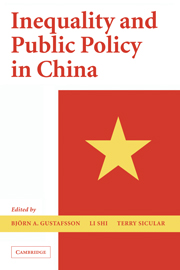Book contents
- Frontmatter
- Contents
- List of Tables and Figures
- Contributors
- Acknowledgments
- 1 Inequality and Public Policy in China: Issues and Trends
- 2 Income Inequality and Spatial Differences in China, 1988, 1995, and 2002
- 3 Growth and Distribution of Household Income in China between 1995 and 2002
- 4 Explaining Incomes and Inequality in China
- 5 The Distribution of Wealth in China
- 6 Growth, Inequality, and Poverty: A Comparative Study of China's Experience in the Periods before and after the Asian Crisis
- 7 What Has Economic Transition Meant for the Well-Being of the Elderly in China?
- 8 Inequity in Financing China's Health Care
- 9 China's Emerging Urban Wage Structure, 1995–2002
- 10 Unemployment, Earlier Retirement, and Changes in the Gender Income Gap in Urban China, 1995–2002
- 11 What Determines Living Arrangements of the Elderly in Urban China?
- 12 The Impact of Village-Specific Factors on Household Income in Rural China
- 13 The Redistributive Impact of Taxation in Rural China, 1995–2002: An Evaluation of Rural Taxation Reform at the Turn of the Century
- Appendix: The 1995 and 2002 Household Surveys: Sampling Methods and Data Description
- Index
- References
3 - Growth and Distribution of Household Income in China between 1995 and 2002
Published online by Cambridge University Press: 25 July 2009
- Frontmatter
- Contents
- List of Tables and Figures
- Contributors
- Acknowledgments
- 1 Inequality and Public Policy in China: Issues and Trends
- 2 Income Inequality and Spatial Differences in China, 1988, 1995, and 2002
- 3 Growth and Distribution of Household Income in China between 1995 and 2002
- 4 Explaining Incomes and Inequality in China
- 5 The Distribution of Wealth in China
- 6 Growth, Inequality, and Poverty: A Comparative Study of China's Experience in the Periods before and after the Asian Crisis
- 7 What Has Economic Transition Meant for the Well-Being of the Elderly in China?
- 8 Inequity in Financing China's Health Care
- 9 China's Emerging Urban Wage Structure, 1995–2002
- 10 Unemployment, Earlier Retirement, and Changes in the Gender Income Gap in Urban China, 1995–2002
- 11 What Determines Living Arrangements of the Elderly in Urban China?
- 12 The Impact of Village-Specific Factors on Household Income in Rural China
- 13 The Redistributive Impact of Taxation in Rural China, 1995–2002: An Evaluation of Rural Taxation Reform at the Turn of the Century
- Appendix: The 1995 and 2002 Household Surveys: Sampling Methods and Data Description
- Index
- References
Summary
Introduction
This chapter presents a broad overview of income and its distribution in China based on the findings of the CHIP survey of households for 2002 and compares them with the findings of the earlier CHIP surveys of 1995 and 1988. The present survey, like its predecessors, has generated some surprises. Chief among them is the finding that, contrary to expectations, income inequality actually declined somewhat between 1995 and 2002 in both city and countryside, taken separately. Due to a still-expanding gap between average urban and average rural incomes, however, the Gini ratio for urban and rural income taken together remained unchanged from 1995.
This third round of the CHIP survey in 2002 was the first time that a separate survey of migrant households was carried out. This provides an opportunity for the first time to get a more comprehensive picture of income and its distribution in urban China and China as a whole including the migrant population in urban areas. We find that migration had definite effects on income distribution, increasing urban inequality but slightly reducing inequality in the overall national distribution of income, and that it helped ease the problem of rural poverty. Continued improvement in rural income distribution is likely to require a combination of policies, including improvement in farm factor productivity, promotion of nonfarm activities in the countryside while improving access of the poor to them, and continuing support for an orderly outflow of rural labor.
- Type
- Chapter
- Information
- Inequality and Public Policy in China , pp. 61 - 87Publisher: Cambridge University PressPrint publication year: 2008
References
- 10
- Cited by



